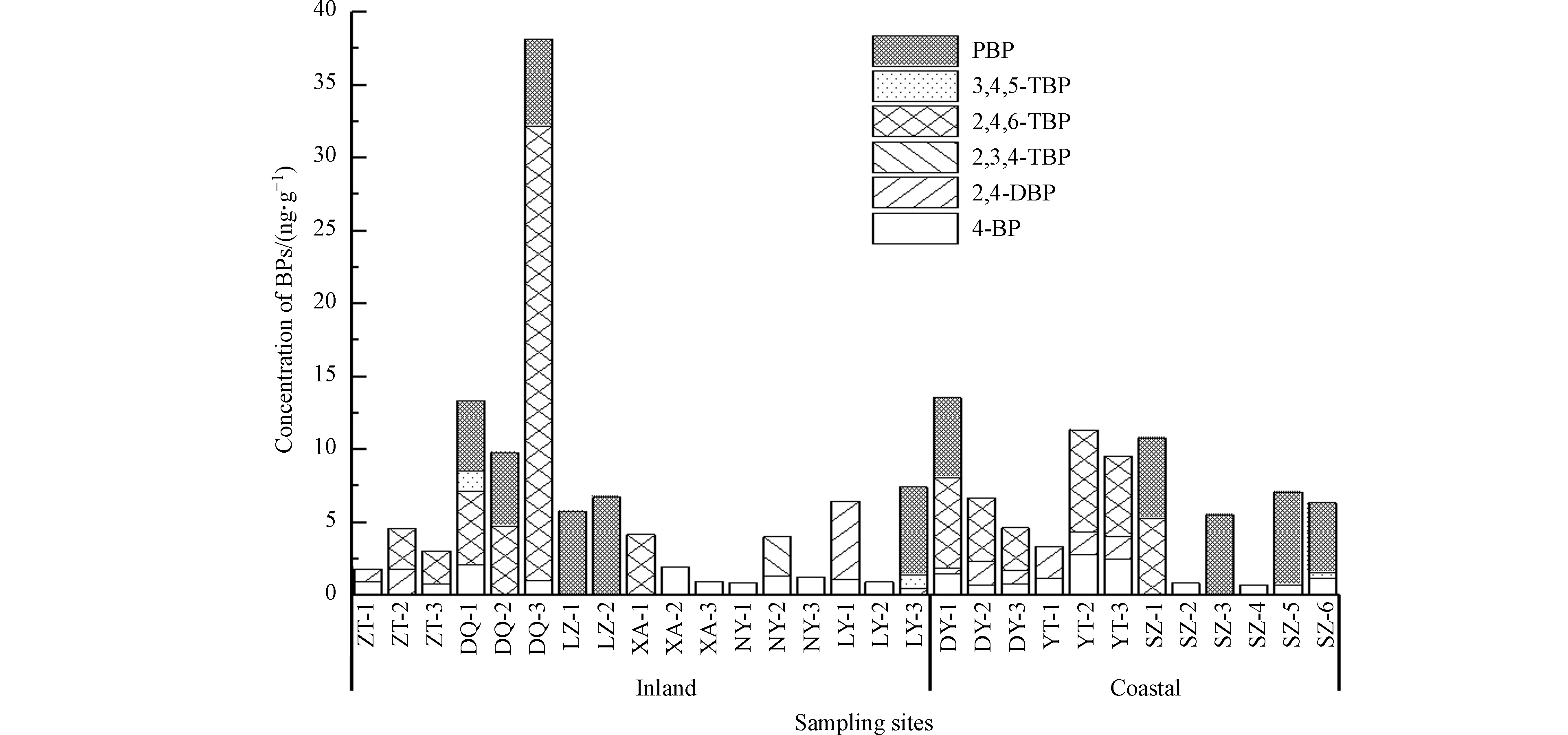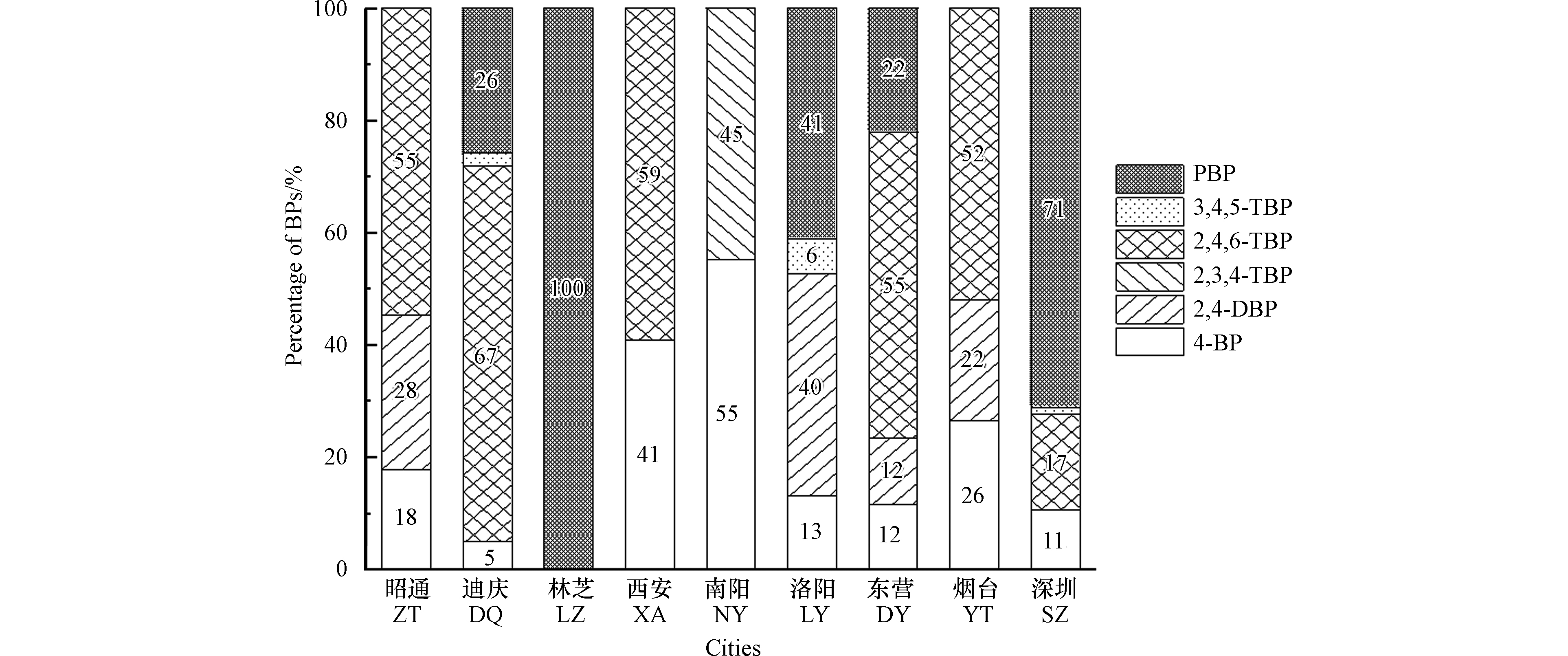-
根据溴原子取代个数及位置的不同,溴酚(BPs)可分为单溴酚(BP)、二溴酚(DBP)、三溴酚(TBP)、四溴酚(TeBP)和五溴酚(PBP)。环境中的BPs存在天然来源和人为来源,BPs作为重要的海洋风味物质,可以由海洋生物天然合成[1],而作为诸多溴代阻燃剂和木材防腐剂的合成原料,BPs也被大量人工合成[2-3];此外,BPs还可由含溴有机物经氯化消毒、光降解等多种环境转化过程产生[4-5]。研究表明,BPs具有较强的内分泌干扰效应,如甲状腺激素效应和雌激素效应等[6-7],也能损伤动物的肝脏、肾脏等组织[8-9]。在大气、地表水、甚至人体血清等多种介质都有检出[4, 10-11]。我国广东省某电子垃圾拆解地的土壤及拆解车间的颗粒物中均检测到BPs[12-13] 。BPs具有较强的挥发性,海洋中大量的BPs通过挥发作用进入大气,然而,人们对空气中BPs的赋存特征了解十分有限。
多种树木的树皮已经被用作空气被动采样器,用以评价空气中的污染物浓度水平。但有研究表明,树皮中有机污染物的富集与树皮样品的脂质含量、蛋白质含量以及树皮形貌等多种因素相关,因此不同种类的树皮对污染物的富集存在一定的差异性[14]。而且,用树皮作为被动采样器评估大气环境污染时,有机污染物除了来自当地的污染源排放外,城市间的传输也可能对其分布造成一定影响,并可通过“全球蒸馏效应”迁移至各个地区,在高纬度或高海拔的低温条件下还可能发生冷凝富集作用[15-16]。因此,为全面了解我国大气环境中溴酚的赋存情况,同时为避免由树皮种类不同对环境污染物评估造成的不确定性,本次研究只选择了一种树种,即广泛用于被动采样和大气污染评估的松树开展研究,在我国内陆及沿海地区的9个城市,针对在我国具有广泛分布的油松进行树皮样品采集,对其中的BP单体进行测定,以探究BPs在我国大气中的赋存和分布特征。
-
19种溴酚的混合标准品WEL-BRPS(2-BP、3-BP、4-BP、2,3-DBP、2,4-DBP、2,5-DBP、2,6-DBP、3,4-DBP、3,5-DBP、2,3,4-TBP、2,3,5-TBP、2,3,6-TBP、2,4,5-TBP、2,4,6-TBP、3,4,5-TBP、2,3,4,5-TeBP、2,3,4,6-TeBP、2,4,5,6-TeBP 和 PBP,每种单体浓度为5 μg·mL−1)和稳定碳同位素标 WEL-MBRPS (13C6-4-BP、13C6-2,4-DBP、13C6-2,4,6-TBP、13C6-2,3,4,6-TeBP 和13C6-PBP,每种单体浓度为5 μg·mL−1)购自 Wellington Laboratories(加拿大)。醋酸铵(Ammonium Acetate,NH4Ac,固体,HPLC级)购自Dikma Technologies Inc.(中国),实验中使用的超纯水(18.2 MΩ·cm)由Milli-Q Adcantage A10系统(美国)制备。甲醇(HPLC级)购自 JT Baker(美国)。
-
2020年7—8月,在我国内陆(inland)及沿海(coastal)地区多个城市采集油松树皮样品。青藏高原和云贵高原为我国四大高原之二,具有高海拔、低气温的特点,青藏高原更有“世界屋脊”之称。虽然两地区的人为生产活动相对沿海地区较少,但多项研究表明这些地区仍然存在多种环境污染[17-20]。因此,选择了位于青藏高原的西藏林芝市,以及位于云贵高原的云南省昭通市和迪庆藏族自治州作为较高海拔的内陆地区采样城市。陕西省和河南省位于中国内陆腹地,连接着多个省份且具有相对较低的海拔高度,与高原地域特征具有较大差别。为了解这类地域的BPs赋存特征,选取了河南省的南阳市和洛阳市、陕西省西安市作为低海拔内陆城市进行了采样。深圳市位于我国华南地区,近年来经济飞速发展,成为粤港澳大湾区的四大中心城市之一;山东省是我国华东地区的沿海省份,其中东营市东临渤海,北靠京津唐经济区,烟台市南邻黄海、北濒渤海,均为环渤海经济圈的重要城市。因此,选择以上3个城市作为沿海地区的采样城市。每个城市选取2—3个采样点,共29个采样点。采样信息见表1。
每个采样点选择3棵树茎约15 cm左右的油松,各松树的间距在20—50 m范围内。用不锈钢刀割取树干上约1.5 m高度处的鳞片状树皮,同一采样点的树皮样品混合后组成一个混合样品。样品用自封袋排气后密封,用冰块使样品保持低温并尽快送至实验室,于−20℃冰箱储存。
-
树皮样品超纯水清洗后,冷冻干燥7 d。树皮用不锈钢刀刮取外层2 mm厚部分,研磨成粉,于−20 ℃冰箱保存。
称取0.2 g的粉末状树皮样品置于盛有1.5 mL甲醇和两颗小钢珠(5 mm)的2 mL离心管中,加入碳同位素标MBRPS (13C6-4-BP、13C6-2,4-DBP、13C6-2,4,6-TBP、13C6-2,3,4,6-TeBP 和13C6-PBP),用组织研磨仪以30 Hz的频率高速振荡萃取3 min,然后以10000 r·min−1的转速离心10 min后提取上清液,重复萃取3次,合并上清液。将上清液氮吹至近干后,加入7 mL水:甲醇混合溶液(95:5,V/V),复溶。
依次用5 mL甲醇和5 mL超纯水活化HLB固相萃取小柱(200 mg, Waters, Milford, MA)。然后将样品通过HLB小柱进行净化,调节流速为每分钟20—30滴。待样品溶液完全流干后,用12 mL甲醇洗脱含有溴酚的极性组分,氮吹后用甲醇定容至500 μL。
-
采用 UltiMate 3000超高效液相色谱仪(Thermo Fisher Scientific Inc,USA)与AB 5500三重四极杆质谱仪(AB Sciex Inc,USA)联用系统对样品中的溴酚进行定性和定量分析。液相色谱流动相为含有1 mmol·L−1 NH4Ac 的水和甲醇的混合液,梯度洗脱程序为:初始水相和有机相的比例为55∶45,在15 min内比例逐渐变为30∶70,然后在5 min内变为 20∶80 并维持 3 min,并在4 min内比例逐渐变为40∶60,随后在0.5 min内将流动相比例迅速改变为初始比例(55∶45),维持该比例2.5 min。色谱系统选用了Inertsil ODS-4型号的色谱柱,进样体积为5 μL,色谱柱温度为40 ℃,流动相流速为0.3 mL·min−1。质谱中离子源为电喷雾电离源(Electrospray ionization,ESI),温度设为500 ℃。采用多反应监测模式(Multiple reaction monitoring,MRM)和负离子模式(negative)进行测定,设定毛细管电压为3000 V。
-
每批次样品处理均添加过程空白和过程加标样品,过程空白中未发现操作引起的BPs污染,过程加标样品中溴酚的回收率在60%—110%之间。进样过程中每隔4针进样1针溶剂空白(甲醇),并未发现化合物在色谱柱上的残留效应。定量分析使用19种BPs的混标所制得的标准曲线,其浓度梯度为0.1、0.2、0.5、1、2、5、10、20、50 ng·mL−1,所得线性相关系数大于0.998。样品浓度均基于干重进行计算(dry weight, dw),每个样品浓度均利用同位素内标的回收率进行校正。BPs的检出限(S/N=3)为0.009—0.02 ng·g−1 dw。
-
表2列出了各城市采样点油松树皮中总溴酚的浓度(∑BPs,ng·g−1)及平均值。总体而言,所有树皮样品均有溴酚检出,其中∑BPs最高值检测于迪庆的DQ-3样品,为38 ng·g−1;最低值出现在深圳的SZ-4样品,为0.69 ng·g−1。所有样品的平均浓度为6.6 ng·g−1。
为比较同一城市不同采样点样品中溴酚的分布差异,计算了城市各样品点间的∑BPs标准偏差σ,见表2。可以看出,迪庆自治州有本次研究中最高的∑BPs含量,3个样点的浓度范围在9.8—38 ng·g−1之间,样点间溴酚浓度的差异也最大。昭通、西安和南阳的溴酚浓度相对较低、分布差异小,其∑BPs均值分别为3.1、2.3、2.0 ng·g−1。相比之下,山东省烟台市和东营市的各样点均具有高检出水平,∑BPs值在3.3—14 ng·g−1间,反映了山东地区溴酚浓度较高的特征。深圳市树皮中的∑BPs均值处于中值水平,其中4个样品的∑BPs值高于5 ng·g−1而其余2个样品的值仅1 ng·g−1以下,将该市样品的∑BPs浓度分为两组(5 ng·g−1以上和1 ng·g−1以下)进行独立样本t检验,发现两组间存在显著性差异(P=0.011<0.05),反映出深圳市内溴酚的显著差异性分布。此外,从地域分布来看,沿海地区的东营市、烟台市和深圳市的树皮样品中∑BPs均值含量分别8.2、8.1、5.2 ng·g−1,3个沿海城市的树皮样品中∑BPs均值为6.7 ng·g−1。而内陆地区的各城市中,除树皮BPs含量异常显著的迪庆外,其余五个城市的树皮∑BPs含量仅在2.0—6.2 ng·g−1之间,均值为3.7 ng·g−1。若将内陆城市分为内陆高海拔城市(昭通、迪庆和林芝)和内陆低海拔城市(西安、南阳和洛阳),3个内陆高海拔城市的树皮∑BPs均值为10 ng·g−1,而3个内陆低海拔城市的∑BPs均值为3.1 ng·g−1。由此表明,沿海地区的溴酚水平整体稍高于内陆地区,而在某些高海拔地区可能存在较高浓度的溴酚。
此外,研究发现同一城市的溴酚分布可能受海拔高度的影响。云南迪庆的植物样品分别采自白马雪山的山底、山腰和山顶,海拔高度分别为2800 m、3495 m和4125 m,其中4125 m是本次采样的最高海拔,其对应样品的∑BPs浓度为38 ng·g−1,远高于山底(13 ng·g−1)和山腰样品(9.8 ng·g−1)的∑BPs值,也是本次分析结果的最大值。Tian等研究发现电子垃圾场地植物的PBDEs含量与周围温度存在负相关关系,高温易促进植物中半挥发性有机物的蒸发而降低含量[21]。Wang等在青藏高原的表层土壤中发现了多氯联苯和多溴二苯醚的浓度与海拔高度的正相关关系[22]。在本研究中,迪庆白马雪山山顶由于海拔较高而具有更低的温度,大气中的溴酚在该地区更容易冷凝富集在树皮中,其中高山冷捕集效应可能是造成该样点具有高浓度溴酚的重要原因。
-
各地树皮样品中溴酚的单体组成和浓度如图1所示。树皮样品共检测出4-BP、2,4-DBP、2,3,4-TBP、2,4,6-TBP、3,4,5-TBP和PBP的6种溴酚,检出率分别为72%、34%、3.5%、41%、10%和38%,表明 4-BP、2,4-DBP、2,4,6-TBP和PBP是我国环境中分布广泛的溴酚单体。有研究显示,山东某化工厂的废水中存在微量的4-BP、2,4-DBP和2,4,6-TBP[23],广东电子拆解场地的土壤中以及排放的颗粒物中则含有高浓度的4-BP、2,4-DBP、2,6-DBP、2,4,6-TBP[12-13],我国北江江水中也发现了微量的2,4,6-TBP和PBP[24],这些研究检测到的溴酚单体与本研究在树皮样品中检测到的结果类似,进一步表明以上几种溴酚在我国环境中的广泛分布。
图2是以城市为单位的溴酚各单体比例堆积图。其中,检出率最高的4种溴酚4-BP、2,4-DBP、2,4,6-TBP和PBP的含量占总浓度的比例也最大。
2,4,6-TBP是环境中最主要的溴酚单体,在6个城市中均占有重要比例,其中除深圳外的5个城市中占比均超过50%,而位于云南省迪庆藏族自治州的DQ-3样品的2,4,6-TBP含量在所测样品中含量最高,达到31 ng·g−1。4-BP是分布最广的溴酚,在除林芝外所有城市中均有检出,虽然也占有较高比例,但其浓度水平普遍不高。结合图1可知,PBP是环境水平仅次于2,4,6-TBP和4-BP的溴酚,在已检出的多个样点中浓度接近,其值在4.8—6.7 ng·g−1之间。2,4-DBP在昭通、洛阳、东营和烟台的4个城市均有较高的检出率,其中东营和烟台的所有样点均有检出,表明两城市2,4-DBP广泛分布的特征,但在其余城市的样品中未有检出。2,3,4-TBP和3,4,5-TBP只在少数地区检出。
-
诸多研究表明,海洋生物体系是溴酚主要的天然来源,其中的藻类、多毛纲等多种生物可自身合成2-BP、4-BP、2,4-DBP、2,6-DBP和2,4,6-TBP,而常用于化工生产的人为源溴酚有4-BP、2,4-DBP、2,4,6-TBP和PBP[1, 3]。因此,可参照溴酚的种类并结合环境中的分布特征对我国环境中的溴酚来源进行初步分析。
树皮是良好的大气POPs污染监测指示剂,既可凭借其表面的多孔结构捕获大气细颗粒物,也可通过其含有的脂质吸收空气中的亲脂性气态有机物。虽然目前暂无关于溴酚的气相-颗粒相分配系数的研究,但有研究表明卤代有机物的挥发性随着卤原子数的增多而降低,因而低卤代物更易存在于气相而高卤代物则多存留于颗粒相[25-26]。本研究中,溴化程度最低的4-BP具有最强的挥发性,容易因大气的传输而稀释,因而其浓度分布普遍较低。云南、西藏等距海洋遥远的内陆城市样品中也有检出,表明这些地区的4-BP除了天然来源外,可能更多的受到人为来源的影响,而沿海城市烟台具有显著高于其他各城市的浓度均值,表明除人为源的影响外,海洋天然来源也具有较强的影响,使其浓度由于天然源的输入而高于内陆城市。
2,4,6-TBP和PBP属于高卤代溴酚,挥发性较低溴代溴酚低,长距离迁移能力也较低溴代溴酚低,因此检测出2,4,6-TBP和PBP的样点附近可能存在对应溴酚的排放源,而内陆地区仅少数样点检测出2,4-DBP也表明其周围存在人为源。山东省东营市和烟台市的所有样品均检测出2,4-DBP和高于整体水平的2,4,6-TBP,据调查,东营和烟台所处的莱州湾地区是我国主要的卤代有机物生产地之一,Chi等分析了同处莱州湾地区的山东省潍坊市某化工厂的工业废水以及渤海的海水样品,发现工业废水中存在较高浓度的2,4-BP((1.7±0.087)×103 ng·L−1)和2,4,6-TBP((7.1±0.34)×103 ng·L−1),而海水中二者的浓度虽然较废水中低,但也分别达到了(1.0±0.11)×102 ng·L−1和(68±1.0)ng·L−1,推测化工厂是以上两种溴酚的重要来源,因此可能对其在该地区空气中的分布具有重要影响[23]。溴酚还有可能来源于其他有机污染物的环境转化过程。有研究表明东营市树皮中的PBDEs含量高达29—190 ng·g−1 lw[27],而PBDEs在紫外照射下可裂解生成多种低溴代苯酚,特别是易于生成间位取代的溴酚,其产物水平为2,4-DBP >2,5-DBP >2,4,6-TBP >2,4,5-TBP[28]。此外,溴苯甲醚等其他溴代有机物也能通过生物或非生物转化作用生成溴酚,这些溴代化合物作为重要的化工材料,在我国大气环境中已被广泛检出[29-30]。基于上述分析,可以推测山东东营和烟台的2,4-DBP和2,4,6-TBP除天然源的贡献外,应该主要来自人为源,其中还有部分可能源自溴代有机物的环境转化。
-
本文分析了我国多个城市采集的油松树皮样品中BPs的污染水平及组成特征。结果表明,树皮样品中检出了6种溴酚,∑BPs的浓度范围为0.69—38 ng·g−1,平均浓度为6.6 ng·g−1,沿海城市油松树皮中检出的BPs单体种类和浓度整体高于内陆城市,此外发现树皮中BPs的浓度还在一定程度上随海拔的升高而升高。基于不同城市树皮样品中BPs单体的组成特征分析来源的影响,认为沿海城市和内陆城市大气环境中的溴酚均受人为源的重要影响,而沿海地区的低溴代溴酚水平则由于天然源的输入而高于内陆城市。本文以油松树皮为指示剂,首次针对我国不同城市大气环境中溴酚化合物的赋存和分布开展研究,为了解我国环境中的BPs污染现状和风险评估提供了基础数据。
我国不同城市油松树皮中溴酚的赋存特征
Occurrence of bromophenols in pine bark from different cities in China
-
摘要: 本文采集了我国内陆和沿海地区多个城市的油松树皮样品,利用超高效液相色谱-质谱(UPLC-MS/MS)联用技术,分析了样品中19种溴酚的赋存特征。结果表明,树皮中4-BP、2,4,6-TBP、PBP等3种溴酚分布最广,检出率分别为72%、41%和38%,19种溴酚的总浓度水平在0.69—38 ng·g−1,平均值为6.6 ng·g−1。溴酚的分布存在较大的单体差异及城市差异,沿海城市树皮样品中的浓度高于内陆城市,树皮样品中的溴酚含量整体上随海拔高度的增加而升高。而溴酚的单体分布特征和地区分布差异均与其人为源和天然源密切相关。Abstract: In this study, pine bark samples were collected from several cities in inland and coastal regions of China. The occurrence of 19 bromophenols were analyzed by Ultra Performance Liquid Chromatography-Mass Spectrometry (UPLC-MS/MS). The results showed that 4-BP, 2,4,6-TBP and PBP were the most frequently determined bromophenols in bark with the detection frequencies of 72%, 41% and 38%, respectively. The total concentrations of all detectable bromophenols ranged from 0.69 ng·g−1 to 38 ng·g−1, with an average value of 6.6 ng·g−1. Different spatial and profile distributions of bromophenols were found in different cities. The bromophenols in coastal cities showed relatively high concentrations. And the levels of BPs were generally increased with the increasing of elevation. The differences were closely related to their anthropogenic and natural sources.
-
Key words:
- bromophenols /
- occurrence /
- source analysis
-

-
表 1 样品信息及编号
Table 1. Sample information and number
采样地点Sample sites 树皮Bark 采样地点Sample sites 树皮Bark 云南昭通市鲁甸县刘家山 ZT-1 河南洛阳市吉利区潘安公园 LY-2 云南昭通市鲁甸县老地坡 ZT-2 河南洛阳市吉利区西霞院 LY-3 云南昭通市鲁甸县转角楼 ZT-3 山东东营市玉带河公园 DY-1 云南迪庆白马雪山山底(海拔2800 m) DQ-1 山东东营市森林湿地公园 DY-2 云南迪庆白马雪山山腰(海拔3495 m) DQ-2 山东东营市东城银座广场 DY-3 云南迪庆白马雪山山顶(海拔4125 m) DQ-3 山东烟台市芝罘区西炮台公园 YT-1 西藏林芝市波密县中学旁(海拔2600 m) LZ-1 山东烟台市芝罘区月亮湾景区 YT-2 西藏林芝市波密县中学旁(海拔2900 m) LZ-2 山东烟台市芝罘区金沙滩公园 YT-3 陕西西安市二环南路东段 XA-1 广东深圳市罗湖区翠景山庄 SZ-1 陕西西安市电子科技大学 XA-2 广东深圳市罗湖区东湖公园 SZ-2 陕西西安市大慈恩寺 XA-3 广东深圳市罗湖区洪湖公园 SZ-3 河南南阳市镇平县坤元宫 NY-1 广东深圳市宝安区西湾红树林公园 SZ-4 河南南阳市镇平县人民政府 NY-2 广东深圳市宝安区石环路 SZ-5 河南南阳市镇平县利欣药厂 NY-3 广东深圳市南山区西丽生态公园 SZ-6 河南洛阳市吉利区四十三中 LY-1 表 2 我国部分城市各采样点油松树皮中的∑BPs含量
Table 2. Concentrations of ∑BPs in pine barks from different sampling sites in 9 cities of China
城市
City区域类型
Region type∑BPs浓度/(ng·g−1 dw)
Concentration of ∑BPs平均值/(ng·g−1)
Mean标准偏差/(ng·g−1)
Standard deviation σ样点1 样点2 样点3 样点4 样点5 样点6 昭通 内陆城市 1.8 4.6 3.0 — — — 3.1 1.4 迪庆 内陆城市 13 9.8 38 — — — 20 15 林芝 内陆城市 5.7 6.7 — — — — 6.2 0.69 西安 内陆城市 4.1 1.9 0.91 — — — 2.3 1.6 南阳 内陆城市 0.83 4.0 1.2 — — — 2.0 1.7 洛阳 内陆城市 6.4 0.89 7.4 — — — 4.9 3.5 东营 沿海城市 14 6.6 4.6 — — — 8.2 4.7 烟台 沿海城市 3.3 11 9.5 — — — 8.1 4.2 深圳 沿海城市 11 0.79 5.5 0.69 7.0 6.3 5.2 3.9 注:“—”表示采样点未设置. -
[1] GRIBBLE G W. The natural production of organobromine compounds [J]. Environmental Science and Pollution Research, 2000, 7(1): 37-49. doi: 10.1065/espr199910.002 [2] CHEN G S, KONSTANTINOV A D, CHITTIM B G, et al. Synthesis of polybrominated diphenyl ethers and their capacity to induce CYP1A by the ah receptor mediated pathway [J]. Environmental Science & Technology, 2001, 35(18): 3749-3756. [3] HOWE P D, DOBSON S, MALCOLM H M. 2, 4, 6-Tribromophenol and other simple brominated phenols [J]. IPCS Concise International Chemical Assessment Documents, 2005(66): 8-9. [4] SIM W J, LEE S H, LEE I S, et al. Distribution and formation of chlorophenols and bromophenols in marine and riverine environments [J]. Chemosphere, 2009, 77(4): 552-558. doi: 10.1016/j.chemosphere.2009.07.006 [5] WANG X W, HU X F, ZHANG H, et al. Photolysis kinetics, mechanisms, and pathways of tetrabromobisphenol A in water under simulated solar light irradiation [J]. Environmental Science & Technology, 2015, 49(11): 6683-6690. [6] BUTT C M, STAPLETON H M. Inhibition of thyroid hormone sulfotransferase activity by brominated flame retardants and halogenated phenolics [J]. Chemical Research in Toxicology, 2013, 26(11): 1692-1702. doi: 10.1021/tx400342k [7] OLSEN C M, MEUSSEN-ELHOLM E T M, HOLME J A, et al. Brominated phenols: Characterization of estrogen-like activity in the human breast cancer cell-line MCF-7 [J]. Toxicology Letters, 2002, 129(1/2): 55-63. [8] KOEN Y M, HAJOVSKY H, LIU K, et al. Liver protein targets of hepatotoxic 4-bromophenol metabolites [J]. Chemical Research in Toxicology, 2012, 25(8): 1777-1786. doi: 10.1021/tx3002675 [9] BRUCHAJZER E, SZYMANSKA J A, PIOTROWSKI J K. Acute and subacute nephrotoxicity of 2-bromophenol in rats [J]. Toxicology Letters, 2002, 134(1/2/3): 245-252. [10] TAKIGAMI H, SUZUKI G, HIRAI Y, et al. Brominated flame retardants and other polyhalogenated compounds in indoor air and dust from two houses in Japan [J]. Chemosphere, 2009, 76(2): 270-277. doi: 10.1016/j.chemosphere.2009.03.006 [11] DUFOUR P, PIRARD C, CHARLIER C. Determination of phenolic organohalogens in human serum from a Belgian population and assessment of parameters affecting the human contamination [J]. Science of the Total Environment, 2017, 599/600: 1856-1866. doi: 10.1016/j.scitotenv.2017.05.157 [12] HAN W, WANG S, HUANG H L, et al. Simultaneous determination of brominated phenols in soils [J]. Journal of Environmental Sciences, 2013, 25(11): 2306-2312. doi: 10.1016/S1001-0742(12)60298-8 [13] REN Z F, BI X H, HUANG B, et al. Hydroxylated PBDEs and brominated phenolic compounds in particulate matters emitted during recycling of waste printed circuit boards in a typical e-waste workshop of South China [J]. Environmental Pollution, 2013, 177: 71-77. doi: 10.1016/j.envpol.2013.01.034 [14] LIU Y W, HOU X W, CHEN W F, et al. Occurrences of perfluoroalkyl and polyfluoroalkyl substances in tree bark: Interspecies variability related to chain length [J]. Science of the Total Environment, 2019, 689: 1388-1395. doi: 10.1016/j.scitotenv.2019.06.454 [15] MIAO Y C, GUO J P, LIU S H, et al. The climatology of low-level jet in Beijing and Guangzhou, China [J]. Journal of Geophysical Research:Atmospheres, 2018, 123(5): 2816-2830. doi: 10.1002/2017JD027321 [16] WEISS P, LORBEER G, SCHARF S. Persistent organic pollutants in remote Austrian forests-altitude-related results [J]. Environmental Science and Pollution Research, 1998: 46-52. [17] HU J C, WU J, XU C Y, et al. Preliminary investigation of polychlorinated dibenzo-p-dioxin and dibenzofuran, polychlorinated naphthalene, and dioxin-like polychlorinated biphenyl concentrations in ambient air in an industrial park at the northeastern edge of the Tibet-Qinghai Plateau, China [J]. Science of the Total Environment, 2019, 648: 935-942. doi: 10.1016/j.scitotenv.2018.08.241 [18] GAI N, PAN J, TANG H, et al. Selected organochlorine pesticides and polychlorinated biphenyls in atmosphere at Ruoergai high altitude prairie in eastern edge of Qinghai-Tibet Plateau and their source identifications [J]. Atmospheric Environment, 2014, 95: 89-95. doi: 10.1016/j.atmosenv.2014.06.005 [19] GAI N, PAN J, TANG H, et al. Organochlorine pesticides and polychlorinated biphenyls in surface soils from Ruoergai high altitude prairie, east edge of Qinghai-Tibet Plateau [J]. Science of the Total Environment, 2014, 478: 90-97. doi: 10.1016/j.scitotenv.2014.01.002 [20] YUAN H D, JIN J, BAI Y, et al. Concentrations and distributions of polybrominated diphenyl ethers and novel brominated flame retardants in tree bark and human hair from Yunnan Province, China [J]. Chemosphere, 2016, 154: 319-325. doi: 10.1016/j.chemosphere.2016.03.132 [21] TIAN M, CHEN S J, WANG J, et al. Plant uptake of atmospheric brominated flame retardants at an E-waste site in Southern China [J]. Environmental Science & Technology, 2012, 46(5): 2708-2714. [22] WANG P, ZHANG Q H, WANG Y W, et al. Altitude dependence of polychlorinated biphenyls (PCBs) and polybrominated diphenyl ethers (PBDEs) in surface soil from Tibetan Plateau, China [J]. Chemosphere, 2009, 76(11): 1498-1504. doi: 10.1016/j.chemosphere.2009.06.045 [23] CHI X Y, LIU J Y, YU M, et al. Analysis of bromophenols in various aqueous samples using solid phase extraction followed by HPLC-MS/MS [J]. Talanta, 2017, 164: 57-63. doi: 10.1016/j.talanta.2016.11.010 [24] XIONG J K, LI G Y, AN T C, et al. Emission patterns and risk assessment of polybrominated diphenyl ethers and bromophenols in water and sediments from the Beijiang River, South China [J]. Environmental Pollution, 2016, 219: 596-603. doi: 10.1016/j.envpol.2016.06.021 [25] YAO Y M, CHANG S, SUN H W, et al. Neutral and ionic per- and polyfluoroalkyl substances (PFASs) in atmospheric and dry deposition samples over a source region (Tianjin, China) [J]. Environmental Pollution, 2016, 212: 449-456. doi: 10.1016/j.envpol.2016.02.023 [26] YANG M, QI H, JIA H L, et al. Polybrominated diphenyl ethers in air across China: Levels, compositions, and gas-particle partitioning [J]. Environmental Science & Technology, 2013, 47(15): 8978-8984. [27] HE C, JIN J, LI G Y, et al. Exchange of organohalogen compounds between air and tree bark in the Yellow River region [J]. Chemosphere, 2016, 153: 478-484. doi: 10.1016/j.chemosphere.2016.03.089 [28] BENDIG P, VETTER W. UV-induced formation of bromophenols from polybrominated diphenyl ethers [J]. Environmental Science & Technology, 2013, 47(8): 3665-3670. [29] CHEN L G, MAI B X, BI X H, et al. Concentration levels, compositional profiles, and gas-particle partitioning of polybrominated diphenyl ethers in the atmosphere of an urban city in South China [J]. Environmental Science & Technology, 2006, 40(4): 1190-1196. [30] CHEN Y J, ZHANG A Q, LI H X, et al. Concentrations and distributions of polybrominated diphenyl ethers (PBDEs) in surface soils and tree bark in Inner Mongolia, Northern China, and the risks posed to humans [J]. Chemosphere, 2020, 247: 125950. doi: 10.1016/j.chemosphere.2020.125950 -




 下载:
下载:


